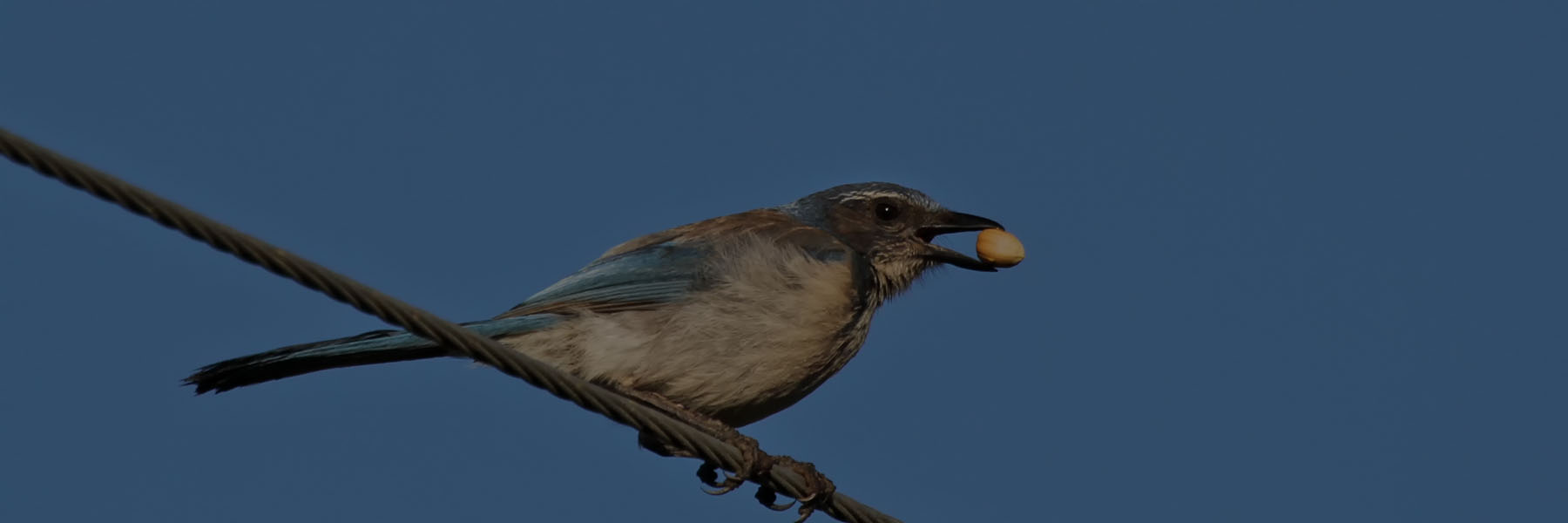Birding in the Pacific Northwest – Part 1
5 CommentsBack in March, I was announced as the winner of Project Feederwatch’s BirdSpotter Photo Contest. The grand prize was a three day trip to Portland, Oregon for me and a friend, courtesy of Bob’s Red Mill. The trip would include birding and a tour of the mill. Of course, I wanted to maximize the birding so I asked my birding friends about when a good time to go was. My friend Chris gave me the name of a Portland native, Dave Irons, who I sent a Facebook message to. Not only did Dave tell me when the best time to go was, he also offered to take us out birding. I sent him my “wishlist” of life birds – I’ve never birded in the Western United States so the list was not small. He replied back that he could get me most of the birds on it in a day’s worth of birding!
I asked my birding-travel-buddy, Renee, to join me. We ended up making plans for the Fourth of July weekend. We knew it would be crowded, but decided to spend the holiday miles away from home, across the country. We added an extra day on our dime so that we had one day to visit Bob’s Red Mill and explore Portland, one day to go birding with Dave and another to head to the coast to see an Oregon coastal specialty – the Tufted Puffin. As the trip grew closer, I asked Dave if he was interested in heading to the coast with us. I can only imagine his thought process when he said yes – it may have went something like “this spot is on the way, then that spot, and then we can go see [insert bird here] in this forest and [insert another bird here] on the way, then get to the coast to see the famous puffins before noon.” It didn’t take long for him to tease us with hints of the birds we can see along the way.
We arrived in Portland in the afternoon on July 2nd. After three flights and two short layovers, we needed some real food. We decided to check out Portland’s famous food trucks and ate more than our stomachs could handle. We walked it off at the Waterfront Park where I saw my first two life birds for the trip – the Violet-green Swallow and California Gull. Then, because we had an early dinner, went to the one of the famous Voodoo Doughnut locations to enjoy dessert.
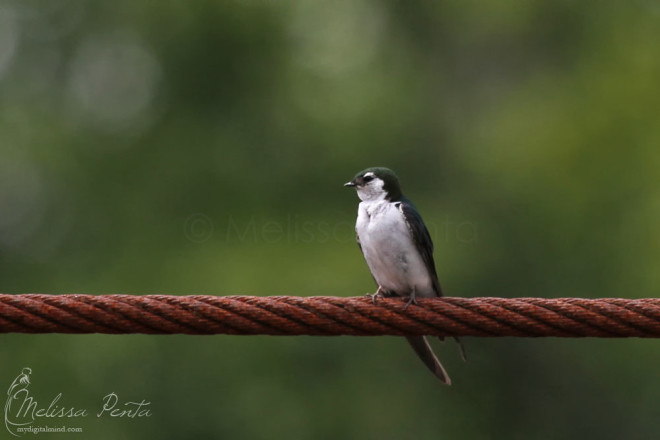
Violet-green Swallow from later on in the trip.
We went to bed early… in fact, it was still light out… but to be fair, we were up since 1AM local time and it was nearing 9PM.
In the morning, we headed across the river to Milwaukie to visit Bob’s Red Mill. We arrived just in time for the tour – it was very interesting to learn the history or Bob’s Red Mill and also nice to see it behind-the-scenes. I never did get to meet Bob because he was in London, but I did get to meet his partner and shell an ear of whole grain corn in his office. After the tour, we stopped at the Bob’s Red Mill Whole Grain Store where we spent my gift certificate and ate some really good food.
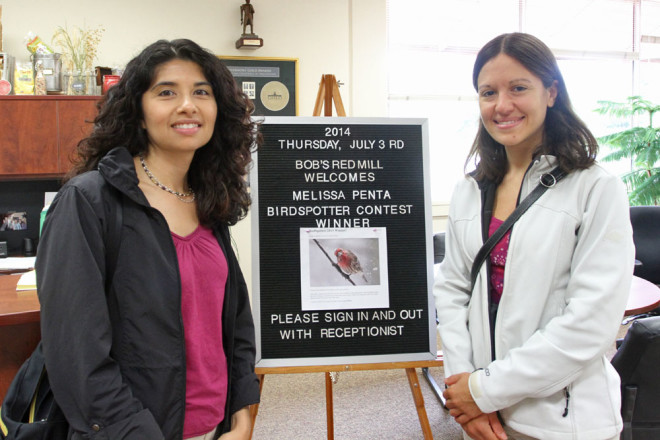
Renee and me at Bob’s Red Mill
We headed over to Washington Park where we explored the Portland Japanese Garden and International Rose Test Garden. Bird-wise, I picked up two more lifers – a family of Black-throated Gray Warblers and a singing Spotted Towhee – and also saw my first Oregon subspecies of the Dark-eyed Junco.
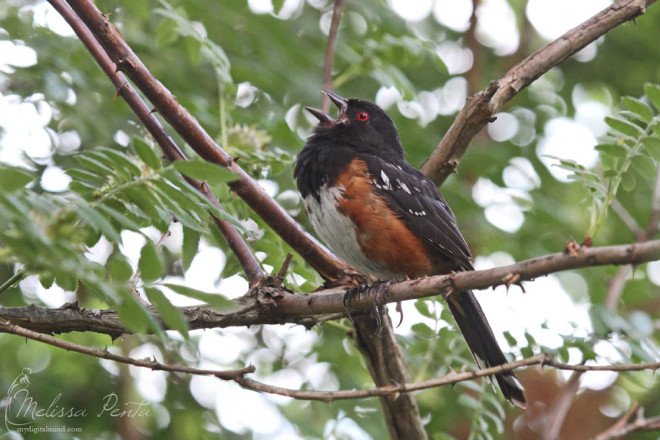
This Spotted Towhee continued to sing even as we were nearby.
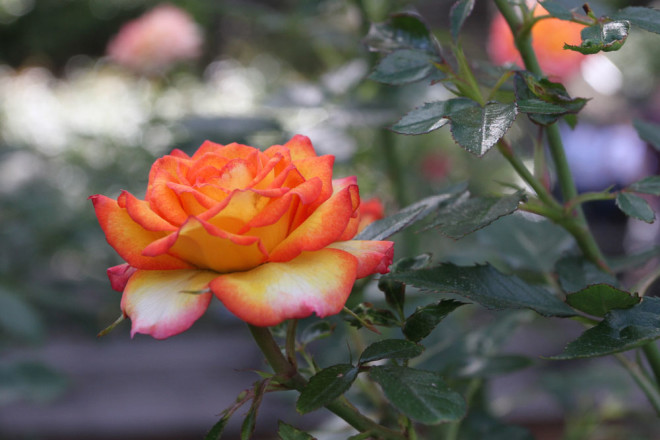
One of my favorite roses from the Rose Gardens.
We explored Portland some more, sampled flights of hard cider at a local brewery, went to an art walk, and ate delicious Thai food in the Pearl District. We ended up going to bed a bit early again because, the next morning, Dave was picking us up at 5:30 AM.
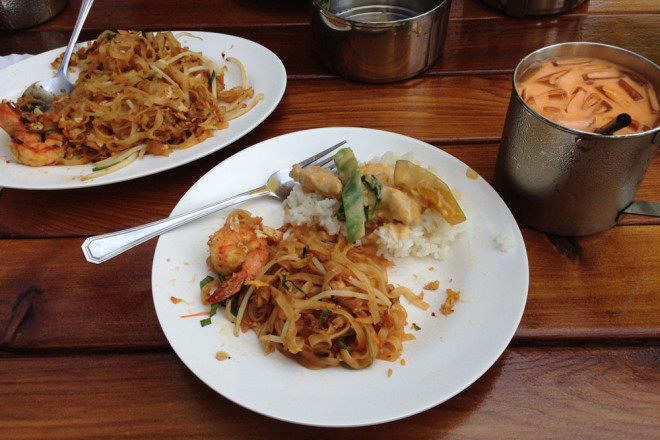
Pad Thai and Pumpkin Curry from Khao San
Dave arrived on schedule with an extra birding guest in the back seat – Rozi, the super relaxed and laid back dog. We eagerly hopped into the car and were on our way. As we drove along the highway, Dave pointed out that the birds on the wires were Western Scrub-Jays – a new bird for me. The local Brewer’s Blackbirds were also new and we even stopped the car so I could get good looks at these common birds.
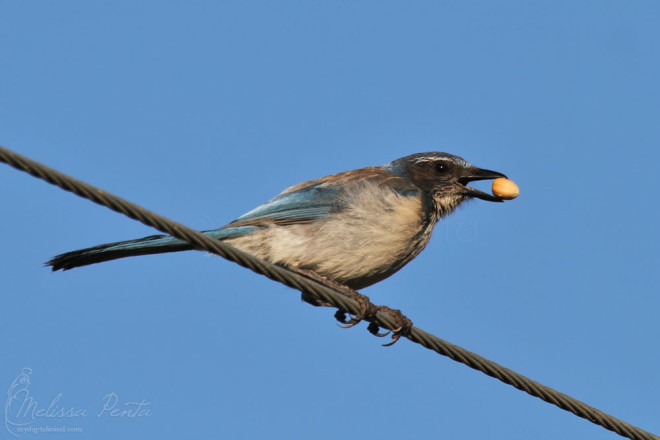
Western Scrub-Jay with a filbert
Or first stop awarded us with a singing Western Wood-PeeWee; we tried to locate it with no luck. We continued up the road to find Acorn Woodpeckers – this would be a lifer for Renee and a US-lifer for me. We eventually found them further down and also got our first looks at a Bullocks Oriole, Black-headed Grosbeaks and a Western Wood-PeeWee who showed himself.
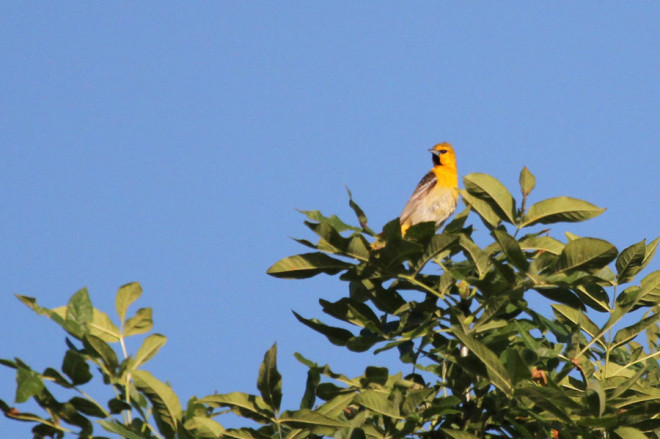
Bullock’s Oriole on the treetops
We made our way to the spot that Dave said we could get a Northern Pygmy-Owl. Renee and I had our doubts about actually seeing this bird but we certainly got more than we bargained for! Dave pulled out a small whistle that resembled a broken recorder (you know, that little instrument that you have to play in grade school?) and started tooting away. The trees started filling up with birds – Hermit and Wilson’s Warblers, Red-breasted Nuthatches, Oregon Juncos – and then we heard the Owl call back from down-hill. The Owl progressively got closer until it flew to a treetop within view. The birds then started to focus on the Owl and were joined by Western Tanagers, Black-headed Grosbeaks and Chestnut-backed Chickadees. Gray Jays gave us some back-lit looks, I saw my first Red-shafted Flicker, a Red-breasted Sapsucker flew in and Band-tailed Pigeons flew by at some point. We were racking up life birds like crazy!
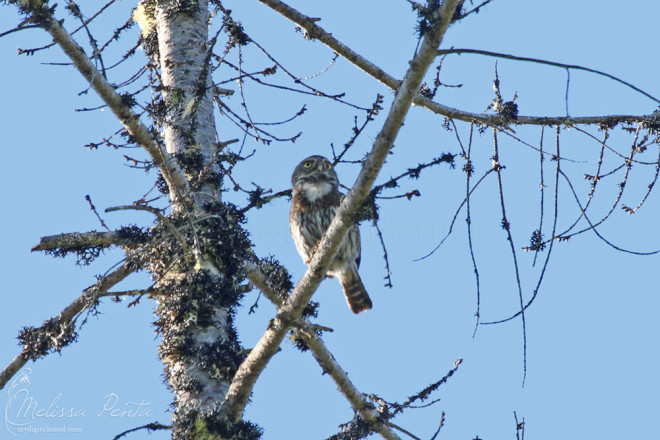
One of the Northern Pygmy-Owl’s great perches
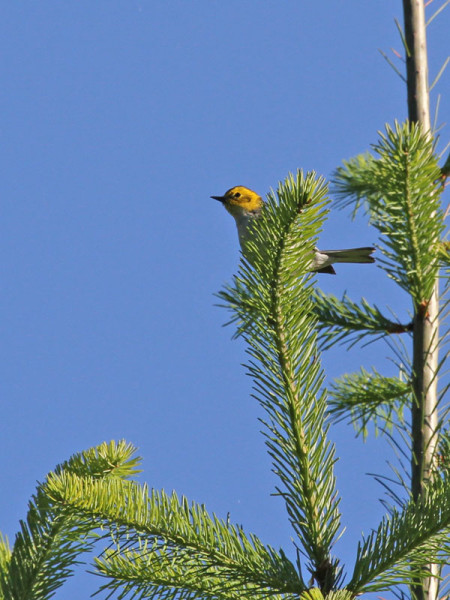
Hermit Warblers were pretty common!
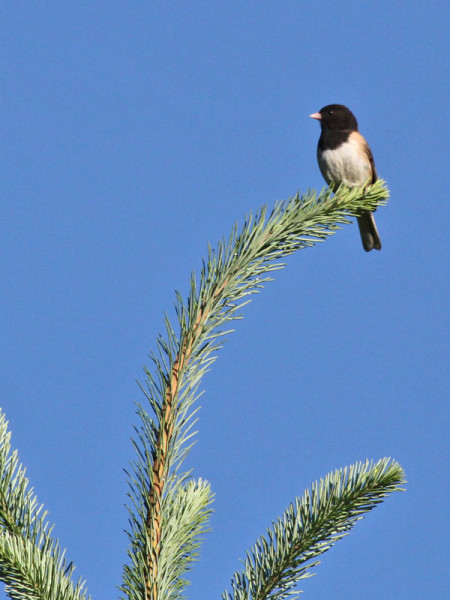
The Oregon subspecies of Dark-eyed Junco
We headed over to Tillamook Forest Center where we could find more birds and, more importantly, have a nice clean restroom. We headed to a small bridge that overlooked a creek and searched for a bird that I was excited about seeing – the American Dipper. Dave found one foraging a bit far off, but not too far for our binoculars.
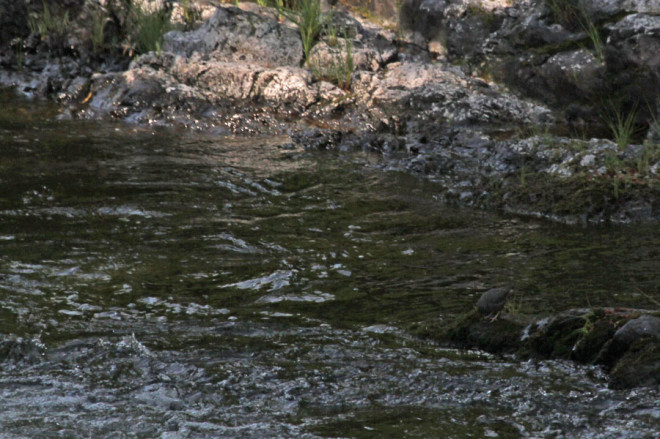
An American Dipper is hidden in here.
We finally headed off to the coast, but not without stopping at Tillamook Creamery on the way. It was 10AM and Dave insisted that we stop here to have some ice cream. We were on vacation so it didn’t take much to convince us to have ice cream for breaskfast. He gave us a 5-minute tour, we sampled some cheese and ordered our ice cream.

Proof that we had ice cream for breakfast.
On the way to the coast, we stopped at Bay City Oyster Company where I got my first Glaucous-winged Gulls. Back on the road, we got caught in holiday traffic. Not just beach traffic – parade traffic. We must have arrived just before the parade and passed crowds of people who waved to the cars passing by. It felt like we were in the parade! What a way to greet the out-of-staters (OK, so they were waving to everyone). Once we broke free from the traffic, we made a stop at Silver Point to do some sea watching. Heermann’s Gulls, Pelagic Cormorants and Brown Pelicans flew by and we had Pigeon Guillemots and a Black Oystercatcher fly in – one of which was my 500th life bird. If only I could remember which I saw first! I think I got my first good scope-looks at the Oystercatcher…
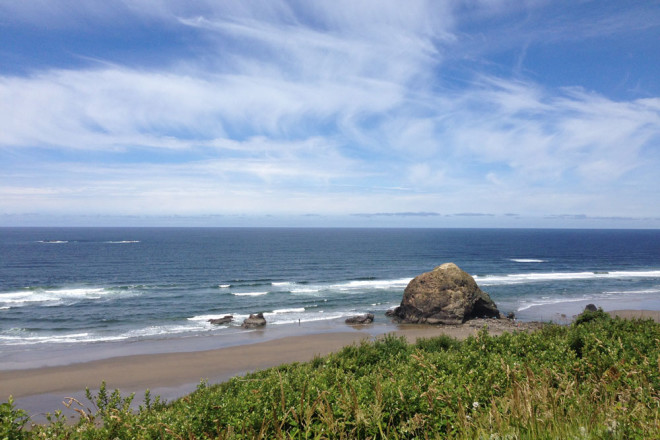
My 500th life bird is somewhere in this photo
And then the moment we were waiting for – not like the rest of the day wasn’t amazing because it certainly was – we arrived at Cannon Beach.
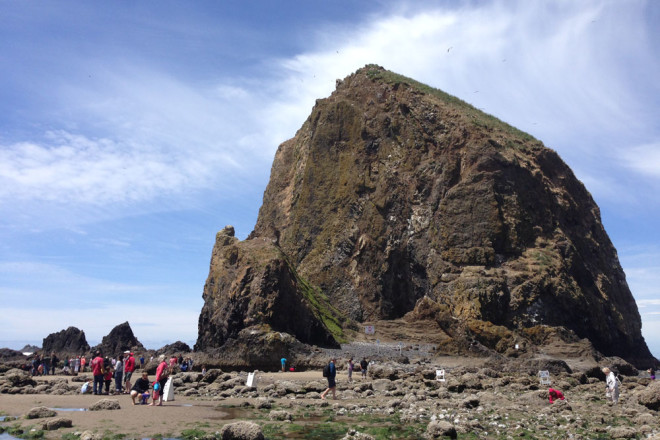
Haystack Rock was full of life birds!
We scoped out the rock from where we parked and got our first looks at Puffins – but Renee and I were itching to get closer. Low tide allowed us to get right up to the rock. Tufted Puffins, Common Murres and Western Gulls flew on and off the rock. The Puffins were, unfortunately, landing on the ocean side where there was more grass. A pair ended up flying on the beach side and we got fantastic scope views. Brown Pelicans were also plentiful and we got more looks at Pelagic Cormorants as well as Brandt’s Cormorants. Harlequin Ducks also swan down low and hung out on the rocks.
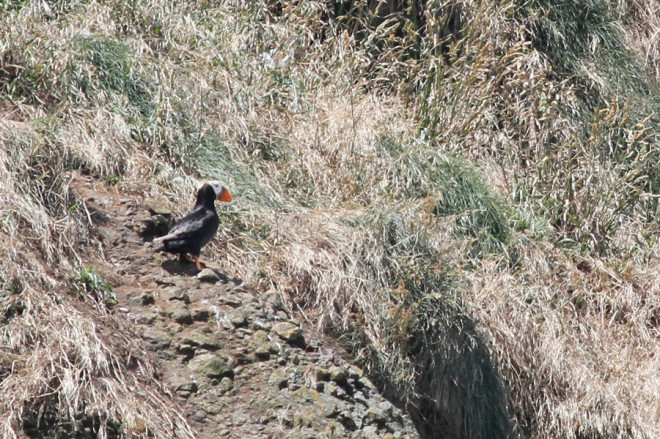
Tufted Puffin on Haystack Rock
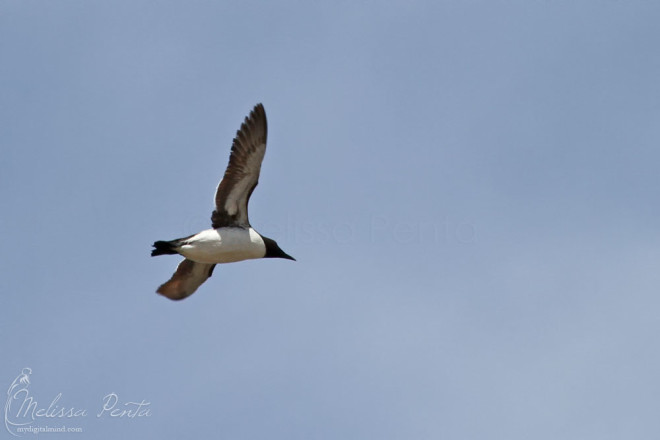
Common Murre flying by
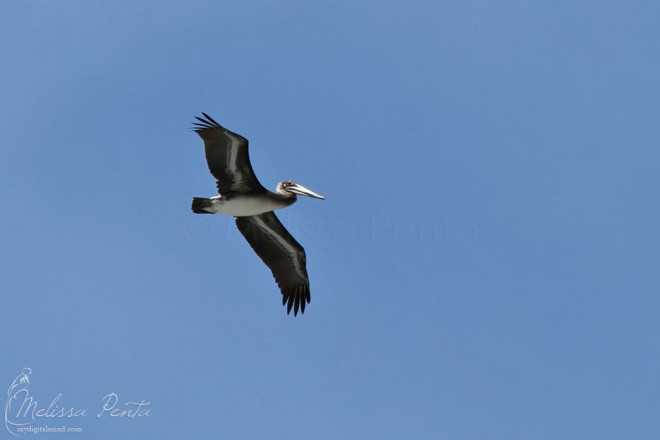
Brown Pelican flying by
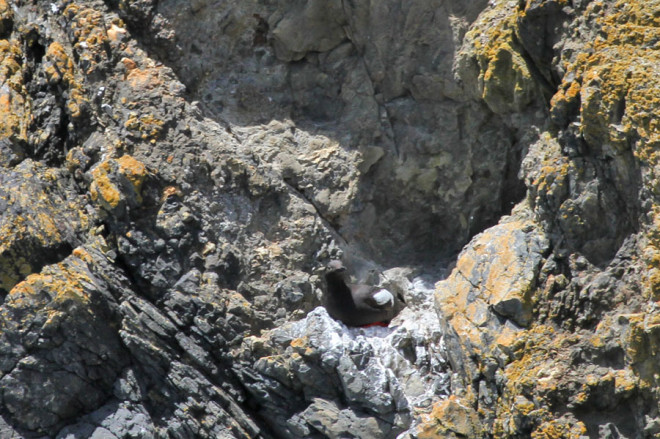
Pigeon Guillemot on the nest
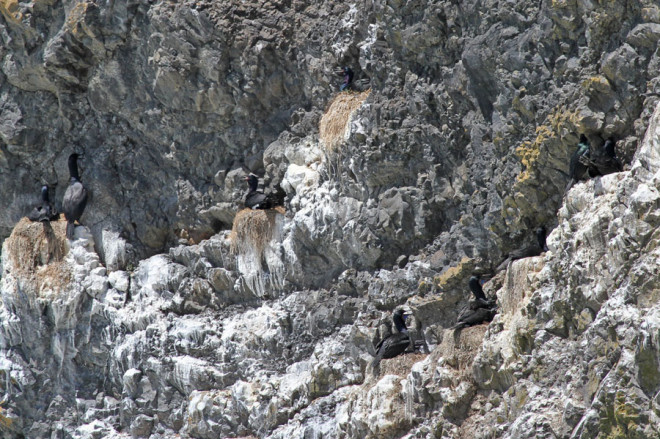
Pelagic Cormorants on their nests
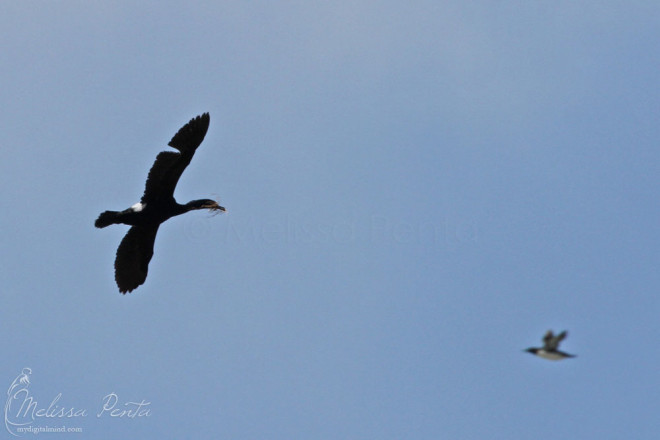
Pelagic Cormorant with Common Murre in the background
After being in a dream world for about an hour, we headed to our next destination – LUNCH! Or, we tried to. Traffic stopped us from going to get fish and chips in Seaside but we did end up making some more bird stops along the way were we looked for Bushtits and Wrentits; it was very hot out so we had trouble finding them. We did, however, stumble upon our first Steller’s Jays and got close to a forging Black-throated Gray Warbler.
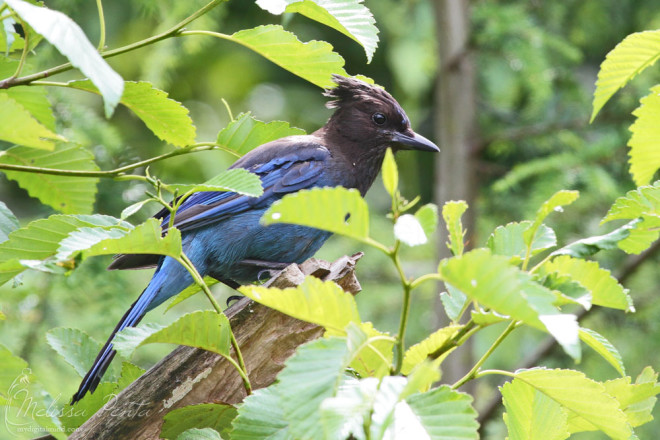
I was so happy to get good looks at Steller’s Jays!

Black-throated Gray Warbler foraging along the road
We ended up hitting some standstill traffic and went a new direction. Dave led us to Camp 18 for lunch. The restaurant was very interesting: built like a huge log cabin with logging equipment laid throughout the property. As soon as we walked inside, we saw bird feeders and gravitated toward them. We ended up having lunch along side Evening and Black-headed Grosbeaks, Rufous Hummingbirds, Purple, House and Goldfinches, Steller’s Jays and a Cooper’s Hawk who swiped up one of the songbirds.

I took this photo of Evening Grosbeaks with my phone – they were eating right outside the glass from me
We had to head home early – we were invited to a Fourth of July BBQ at Dave’s friend’s house – so we headed back after lunch. On the way, we kept an eye out for birds; we specifically tried looking for a Cinnamon Teal but came up empty handed. What we did find was a cooperative Lazuli Bunting.

The Lazuli Bunting’s song reminded me of the Indigo Bunting.
Finding life birds did not stop there – during the BBQ I got good looks at a female Anna’s Hummingbird and a couple of Lesser Goldfinches. No one minded me putting up my binoculars to look at birds – in fact, they encouraged it – it was a yard full of birders after all…
Continued… Birding in the Pacific Northwest – Part 2

